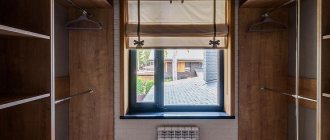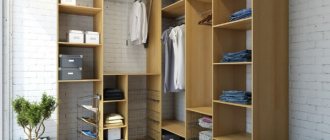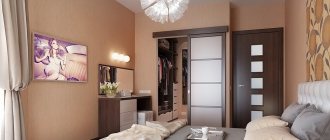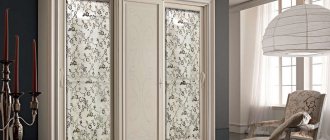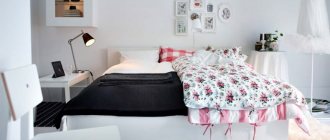Basic wardrobe for women: Needpix A dressing room will help make your home more functional and aesthetically pleasing. Having properly equipped the space, you can store in it not only wardrobe items, but also some household appliances, which is extremely convenient. The size of the dressing room can be small, which will create space for storing things even in a small apartment.
Do you need a dressing room in an apartment?
What is a dressing room? Is it necessary? Today, more and more often, many of us have a desire to acquire and arrange for ourselves a small room where we can conveniently store everyday things. And it doesn’t matter at all where the family lives: either in their own house or mansion, or in a 2-3 room apartment.
In fact, today people have stepped up a notch in terms of organizing and arranging their living space. Long gone are the days when clothes, shoes and boots were stored, hung or stood in closets, chests of drawers and hangers on the walls. And no one remembers the chests at all.
In the interior and design of modern housing, well-defined trends and directions are visible:
- the desire for space and a sense of space;
- free planning (and redevelopment) of residential premises;
- narrow functionality (purpose) of utility rooms.
By creating a dressing room in your apartment, you gain a lot of advantages:
- You no longer have to fill your apartment with various cabinets, chests of drawers, bedside tables, etc.
- If you plan it correctly, you can store not only your wardrobe in it, but also bed linen, all kinds of suitcases and bags, all of which takes up space.
- When stored properly, clothes wear out significantly less, which means their service life increases.
In modern apartments, a dressing room is already provided and the only question that remains is its arrangement. In old apartments, where such a room is not provided, there is always a room, part of which can be separated by a partition and made into your own small dressing room.
Looking for a place for a dressing room
In cases where we are talking about a house or cottage created according to an individual project, everything is simple - this is a separate room with an area of at least 3 m2. A dressing room appears at the project stage, and then it is equipped. The optimal location in the house is closer to the hallway, bathroom or bedroom.
In the case when this is a dressing room in an apartment, there are several options:
- convert a former storage room into a dressing room;
- as a result of internal redevelopment, create (rebuild, build, fence off) space for a future dressing room;
- in a room, usually a bedroom of course, use a partition (sometimes a screen) to create a dressing area;
- during renovation, you can make a niche from plasterboard for a built-in wardrobe (an excellent option for making your wardrobe blend with the interior of the room).
It’s better when there are two dressing rooms: one for outerwear and everyday items closer to the exit; such a dressing room can also be a built-in wardrobe, and the other for other, rarely used clothes, shoes and hats. The location of the 2nd will be already in the depths of the home.
History of appearance
A separate room for storing things is already found in houses of ancient eras. Egyptian pharaohs and patricians of Rome had such places in their luxurious homes.
In medieval Europe, the nobility also preferred to store their outfits in separate rooms designated for this purpose. A large change of clothes was available in different eras only to the privileged strata of society, whose home was palaces and castles.
The development of industrial production, which also influenced the sewing of clothes for mass consumption, led to an increase in purchases of clothing production by different categories of consumers. In the 20th century, dressing rooms in the Old and New Worlds began to appear in actresses and theater divas. The development of the fashion industry has led to an increase in demand for fashionable clothing not only among women, but also among men. At the end of the 20th century, the clothing industry presented a wide range of different styles for every season, for both adults and children.
Due to the growing number of things in the individual wardrobe of a modern person, the need to organize a special place for storing them has become an urgent necessity. Today, such a place can be organized even in a small apartment by developing an individual design for a dressing room.
Organization of dressing room space
Regardless of which living space the dressing room will be in (house, apartment), its vertical space is organized in the same way: the middle part (the largest), upper and lower.
The upper part is usually convenient for storing bedding (blankets, pillows), seasonal clothes in covers and vacuum bags. The location near the ceiling suggests that there will be a small stepladder or folding ladder in the dressing room.
Then the middle part will be occupied by clothes that are needed every day or used quite often, and the lower zone will be space for shoes and shoe boxes.
Structurally, the middle part consists of rods for hangers at a height of no more than 1.9-2 m and a length of up to 1.2 m. For longer lengths, intermediate fastenings are used. Here you also need short shelves (up to 90 cm) for sweaters, blouses, jeans, hats and scarves. The shelves are suitable both open and closed.
If there is sufficient space, it is possible to install cabinets with shirt drawers, racks for trousers and ties.
The part of the dressing room closer to the floor is, first of all, a place for shoes and shoe accessories. For this, shelves 30-40 cm wide are sufficient. Any housewife usually finds a place for out-of-season shoes and those that will be needed today or tomorrow.
The best entry option for a dressing room is a sliding door; for small areas of the home, a curtain on the curtain.
The depth of the space for storing clothes is usually 60-70 cm (from the wall), the passages between hangers, cabinets, shelves - from 70-75 cm.
An example of zoning a room for clothes
Room zoning
When creating an equipped space for storing clothes, pastel accessories and home textiles, you can rationally divide the room into functional zones. To do this, the corner of the bedroom or hallway can be separated from the common space by partitions. It is not necessary to make a new room rectangular; arranging a corner would be an excellent option for a small apartment.
To create partitions separating the dressing room from the rest of the space, you will need:
- drywall;
- metal profiles;
- self-tapping screws
- electric drill
- primer;
- putty
- metal scissors.
First you need to make markings for attaching the profile and drywall. Places for attaching the metal profile are indicated on the walls and floor. Then, according to the dimensions of the future walls, plasterboard is cut and attached to the installed metal profile. The first step is to attach the structures to the floor, then to the walls, and then to the ceiling.
Metal parts and drywall are cut to appropriate sizes. To cut metal, a special tool is used - metal scissors, and drywall is cut with a hacksaw.
The finished metal frame is sheathed with plasterboard. When carrying out this work, you can put a soundproofing layer between the sheets and also install lighting. To do this, electrical wiring is laid at the sheathing stage.
What can you add when there is enough space?
This applies, first of all, to dressing rooms in houses, because in an apartment no owner will create a dressing room comparable in size to, say, a bedroom.
To make the most of your clothing room, you can do the following:
- put an ironing board there and use it for its intended purpose;
- place or hang a mirror and provide an outlet for a hair dryer or curling iron;
- the mirror can also be placed on the cabinet door or on the sliding door;
- An ottoman in the dressing room will allow you to calmly and leisurely do various “shoe” tasks.
Ventilation system layout
A ventilation system is required. After all, the quality of storing things and how long they will last depends on this. Its presence is mandatory in both large and small dressing rooms. Otherwise, things will have a musty smell that will be difficult to remove. Therefore, when planning a dressing room, you should carefully consider the ventilation system.
If there is a window in the dressing room, then nothing can be done here. It is enough to ventilate the room from time to time.
Hood
It is advisable to make the air duct for the hood before renovating the dressing room. It is important to think in advance where it will be used - in a general ventilation system or outdoors. Then the channel itself passes through. It can be carried out using metal or plastic air ducts. There will be no problems with the selection of various parameters of boxes and connecting elements, since now there are simply unrealistic quantities of them on the market: galvanized air ducts and plastic deflectors.
Air extraction
Next, you need to make a hole in the upper part of the wall (preferably away from the door) and install an exhaust device.
As for the fan, it is best to choose one with a low noise level. Because unnecessary sounds from it will be annoying. Especially if the dressing room is in the bedroom or next to it.
Also, when purchasing a device, you should pay attention to the performance of the exhaust fan. Regardless of how many people are in the dressing room, the quality of air exchange in this room should be good. Consultants in the store will help with calculating the volume of the room. The main thing is to tell them the exact parameters of the dressing room: depth, width and height of the room.
You can control the fan yourself using a switch or install a sensor to automatically turn on and off. The second option is more convenient.
Air supply
Air supply can be carried out in three ways:
- The inflow will be provided independently through the gap under the door. The main thing is that it is wide enough, about 2-3 cm. This option is suitable for swing, folding and swing doors.
- Make a rectangular hole at the bottom of the door, just above floor level, and install a decorative grille. Suitable for hinged, folding and hinged doors, as well as sliding doors if they are made of wood.
- Provide air flow through the inlet. To do this, you need to make one hole in the wall, slightly above floor level. It is advisable to do this closer to the door. The hole can be closed with decorative grilles to match the style of the interior. There are no restrictions on which doors will be installed.
Lighting and finishing materials
The functionality of the dressing room and its design depends on the size of the room. With a minimum area of 2 sq. The purpose of the room is one and only: storing clothes and shoes.
With large areas, the dressing room turns into a fitting room, ladies' toilet room, a place for putting clothes in order, etc.
But then the owners will want the interior of the room to be up to standard. What can be used to decorate such a room:
- a variety of wallpapers, but this is the simplest option;
- PVC wall panels;
- internal structures made of chipboard;
- natural wood (solid wood): for cabinets, chests of drawers, tables, poufs, floor hangers. This is the most expensive, but also the most stylish option.
- The larger the dressing room, the more attention should be paid to its lighting.
The principle of reasonableness is this: there should be enough light, but it should not be blinding, and it would be difficult to see the small details of clothing in the mirror.
What is suitable for dressing room lighting:
- ceiling chandelier, but in combination with sconces on the walls and especially next to the mirror;
- ceiling lamps such as mini-spotlights that change the direction of illumination;
- spot lighting (top or side) of cabinets and shelves, possibly lighting the wall behind the clothes;
- Among the latest technical innovations, we can mention motion sensors that are triggered and turn on the light when the doors to the dressing room are opened.
And as a summary, we can say that today you can easily equip a stylish and comfortable dressing room of almost any size. And such a dressing room will accommodate all the necessary things that you will always have at hand.
Practical advice
Instead of plasterboard, MDF or laminated chipboard is also used for cladding.
Once the partitions are installed, you can begin interior decoration. To do this, the seams of the sheets are puttied and primed to create a single space. The sheathing joints between the walls and ceiling are primed. A rough finish will ensure the strength and attractiveness of the interior space.
Finishing
In order for the new functional room to have an attractive exterior, it will need to be cleaned. It’s easier to cover plasterboard partitions with wallpaper. Various panels, natural wood or wall painting are also suitable. The latter finishing method is considered durable. Before painting, it is necessary to prime the walls.
It is necessary to take care of the floor covering. Tiles are suitable for such a room. But its installation is a labor-intensive process that requires professional training. If you want to save on floor finishing, you can use carpet or linoleum.
To protect things from dust, you need to install doors. The best option would be sliding structures that will not take up much space in the bedroom or hallway. From the outside, a large mirror is installed on them and lighting is supplied.
For ease of use of the new premises, lighting is installed in the extension. To do this, before installing racks, shelves and hanging fixtures, the fixtures must be fastened. For a dressing room, it is better to use LED spotlights.
